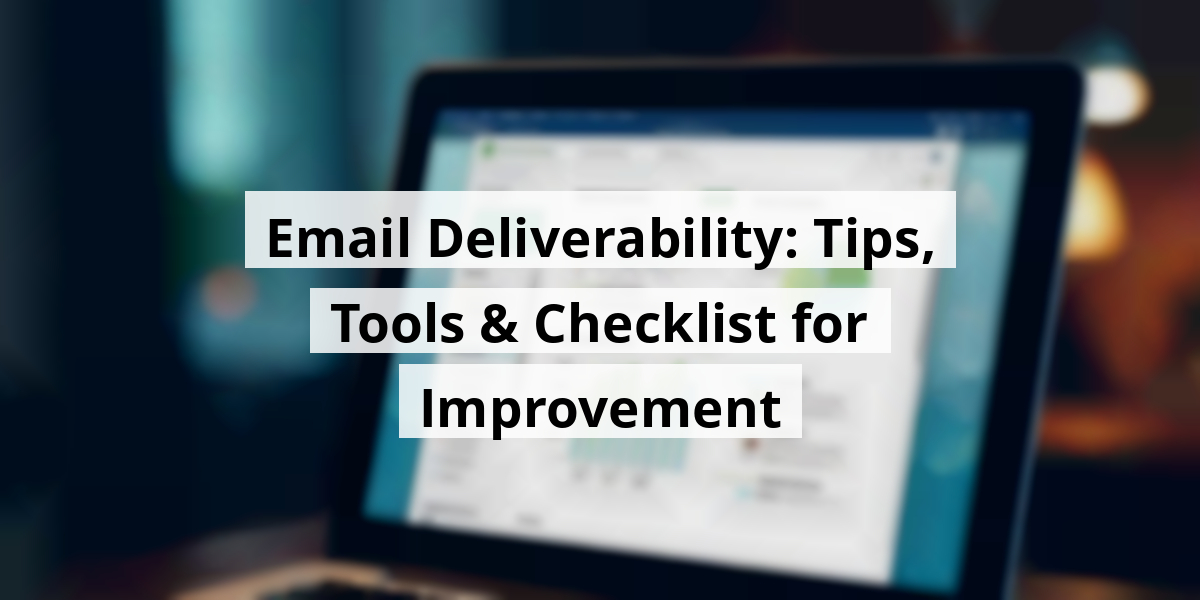 LIMITED SPOTS
All plans are 30% OFF for the first month! with the code WELCOME303
LIMITED SPOTS
All plans are 30% OFF for the first month! with the code WELCOME303

 LIMITED SPOTS
All plans are 30% OFF for the first month! with the code WELCOME303
LIMITED SPOTS
All plans are 30% OFF for the first month! with the code WELCOME303


Now we are going to talk about something that keeps email marketers up at night—email deliverability. Grab a coffee, and let’s untangle this topic.
Email deliverability is basically the magic percentage that tells us how many of our emails end up right where we want them—in the main inbox of our recipients. This is crucial because no one checks their spam folder regularly, right?
For instance, imagine sending out 100 heartfelt emails, only to find out that five of them went MIA, never to be opened. That stings a little, doesn’t it?
Now, getting those emails to land in the primary inbox isn’t just some wishful thinking; it’s vital for our cold emailing and email marketing strategies. After all, how can leads act on emails they don’t even see?
Let’s consider the flip side: a low deliverability rate. You send out emails, but they bounce like a rubber ball. Ouch! That can burn a hole in our marketing budgets faster than we can say “click-through rate.”
We’ve all been there—crafting that perfect message, only to watch it spiral into the dreaded spam folder. The ultimate betrayal!
To keep our email game strong, one of the best ways to check deliverability is by measuring our inbox placement rate. Think of it as the VIP pass for our emails into the main party—who wants to end up in the crowded spam section?
Quick heads up: Deliverability and delivery aren’t the same. Just because your email tool shows "delivered" doesn’t mean it’s chillin' in the right place. It could be hiding, quietly crying in the spam folder. No thanks, we want our messages front and center!
Here’s a little checklist to help ensure our emails are properly invited into their intended inboxes:
Getting our emails delivered properly is half the battle won. Let’s keep our rates high, our lists clean, and our inboxes filled with excitement—not disappointment.
Now we are going to talk about why ensuring our emails land where they should is so vital for success. Let’s be honest—if our carefully crafted email is lost in the digital abyss, all that effort goes down the drain quicker than last week’s leftovers.


Have you ever sent what you thought was a surefire email, only to hear crickets in response? It’s like throwing a party and no one showing up. When emails don’t make it to the intended inbox, that’s a big issue. After all, it doesn’t matter how catchy your subject line is or how enticing the offer looks if it’s lost in cyberspace.
Here are a few consequences that come from poor email deliverability:
For anyone engaged in B2B sales, outreach, or retention campaigns, this is especially crucial. You let your email deliverability tank, and soon even your most supportive contacts might start ghosting you. And nobody wants to be the person whose emails are ignored—it’s just plain awkward.
It's infuriating when we know we’ve got great content. We’ve carefully queued up leads we believe in—only to have technology throw a wrench in our plans. But hold onto your hats—most of these deliverability issues can indeed be resolved with a sprinkle of effort and some strategic tweaks.
Now, how do we avoid finding our emails stranded in the nether? A few pointers might help:
It’s never fun to deal with deliverability problems, but with a bit of patience and diligence, we can steer clear of email limbo and ensure our communications shine where they belong: right in the inbox!
Now we are going to talk about some golden standards for email deliverability rates. Spoiler alert: it’s more complicated than tracking your last online shopping order!

Let’s be real—reaching a 100% email delivery rate is like finding a unicorn in your backyard, or at least that’s what we’ve heard! A good email delivery range sits snugly between 90% and 95%. If you're firing off emails in a B2B context, where you're often shooting messages into the void to people you've never met, that’s pretty solid. We should aim for a bounce rate below 3%, dissected into hard and soft bounces. And don’t forget: your spam rate shouldn’t be north of 0.08%. Unless you’re looking to challenge your emails to a wrestling match with the spam folder, of course!
But here’s the kicker: what’s “good” differs depending on your approach. An email blast to cold leads will naturally see less success than warm and fuzzy emails to loyal customers. If you're hitting that sweet 90-95%, we're tipping our hats to you! That said, measuring these rates isn’t as cut and dry as Aunt Millie's apple pie recipe. No email platform out there—be it Gmail or Outlook—will divulge exactly how many emails landed in the primary inbox versus going awry to spam or promotions. You’d think someone would want to spill the beans, right?
Let’s break down why this info is top secret:
In plain terms:
“Delivered” doesn’t equal “Inboxed”. This can be a rude awakening for many. So how do we gauge success in this wacky email landscape? Here are some metrics that could help clarify the situation:
| Metric | Target Range |
|---|---|
| Inbox placement rate (via specialized email checkers) | 90–95% or higher |
| Bounce rate | Under 2% |
| Spam complaint rate | Under 0.1% |
| Open rate | Varies (20–40% by industry) |
| Sender score/reputation | Above 80/100 |
So, as we venture down the email marketing rabbit hole, remember: always keep your humor intact and your metrics in check! Happy emailing!
Next, we're going to explore the factors that affect email deliverability. Think of it as your emails needing a good home before they can mingle with all the other emails in someone's inbox!
Email delivery isn't just about hitting 'send' and crossing your fingers. It’s a delicate dance that depends on a few key elements. If any step goes wrong, it’s like stepping on your partner’s toes!
Let’s break it down:
Before you slap a confident “send” on that cold email, your domain has to impress the gatekeepers—those email providers who have seen it all and then some. Here’s how:
Once your setup is spick and span, it’s all about how you behave as an email sender. Spoiler alert: too much enthusiasm can backfire!
Even if your setup and behavior are flawless, what matters most is who’s on your list. Bad data is like trying to bake cookies without flour – just a mess.
Using reliable data sources helps maintain list health. Here are some pitfalls to avoid:
Your sender reputation is the health score of your email domain. It’s shaped by spam complaints, bounces, and when people hit ‘unsubscribe.’
Keeping an eye on this is crucial to maintaining a good standing and ensuring your emails don't fall into the dreaded spam folder.
Low open rates are red flags for email service providers. Target higher engagement, like above 20%, to keep their trust.
Buying pre-made lists often leads to embarrassingly low open rates. Instead, invest in tools that ensure genuine connections, as more authentic outreach tends to yield better results!
Follow these strategies, and your cold email motivation might just turn into relation-building gold! 🎉
Now we are going to talk about how to evaluate email deliverability, a crucial yet often overlooked topic in our digital communication.


So, here's a quirky truth: there's no magic number that says, "Congrats! Your email deliverability is 85%!" It's like trying to catch smoke with your bare hands—a bit evasive, really. Email deliverability is a concoction of several factors, all simmering in the pot together:
Sure, email testers might throw a score your way, usually out of 10. But remember, that’s just a snapshot. Like judging a movie from its trailer—there's more to the whole story. So, before we send out a herd of emails, let’s make sure we’re not part of the spam squad. Check these handy steps:
Using Mail Tester provides a score along with insights on any spam triggers you might’ve accidentally set off. Think of it like a friend who tells you that you have broccoli in your teeth before you stroll into a big meeting.
Next, we are going to talk about ways to enhance your email deliverability. We all know the frustration of sending out what feels like a masterpiece, only for it to vanish into the abyss of spam folders. Let’s explore some tips that can help ensure those messages land where they belong: in the inbox!
Imagine this: your email is like a tiny spaceship trying to land on Planet Inbox, but your launch pad is all wobbly. Email providers like Gmail and Yahoo have high-tech radars that check your domain's signals before allowing your email even near the landing zone. If something looks off, they may just send it straight to spamville.
Here’s a quick checklist to ensure your tech setup is in top shape:
Picture a chef warming up a skillet before throwing in a juicy steak; it’s all about heating up gradually. New domains or those with a shaky reputation need a similar treatment. You can’t just jump into sending massive email campaigns; it’s all about building trust one small email at a time.
Here are some golden rules to achieve that warm-up:
No one likes clutter, right? Well, neither do email systems. Maintaining a clean list can drastically improve your deliverability, saving you from potential spam traps.
Here’s how to tidy things up:
If you’ve ever sent an email no one opened, you know the struggle. Spam filters are pretty pay attention to how your emails are received. High open and reply rates signal trustworthiness, while ignored messages? They’re like red flags.
Here’s how to improve your chances of catching attention:
By keeping these tips in mind, we can enhance our email deliverability and avoid the dreaded spam folder, ensuring our messages land where they ought to be—right in the inbox! Happy emailing!
Now we are going to talk about the art of ensuring your emails actually reach the inbox rather than getting dumped in spam land. It’s a delicate dance, really. Here are some email deliverability best practices that we can follow to keep our messages front and center:

Think of your email list like a garden. It needs regular tending to flourish. If you’ve got bounces, spam complaints, or crickets instead of engagement, you’re heading straight for the spam folder. We’ve personally felt that sink in our stomach when an important email didn’t get the attention it deserved. It’s like throwing a party and nobody shows up. Cleaning up your list twice a year is a solid game plan. Look out for those troubling signs like dwindling open rates or lots of folks hitting "unsubscribe." And yes, while there are tools that can help, starting with verified data is your best defense.
We’ve learned that relying on verified data early on can save a world of headaches later. Nothing's worse than getting flagged for using dodgy addresses. It’s like inviting the neighborhood raccoons to your backyard barbecue.
Even the best lists can fall prey to spam filters if your emails feel robotic. Nobody wants to hear a sales pitch that sounds like it was generated by a 1990s robot. Stick to natural conversation—you wouldn’t start a chat with “Hurry, limited time offer!” at a coffee shop, would you? Clear, friendly language is your key here. Forget those flashy fonts and over-the-top images; keep it simple. A good rule of thumb: One or two links max, no emojis, and definitely steer clear of link shorteners that look fishy.
Even simple tweaks to domain settings or email volume can affect deliverability. It’s a bit like adjusting the flavor in a favorite recipe—just a pinch of salt can make all the difference. Regular checks on deliverability will pay off big time. As Lisa Heay once said, “Email optimisation is not a set-and-forget kind of thing.” We couldn't agree more! Here’s what a monthly monitoring routine might look like:
| Task | Tool | Frequency |
|---|---|---|
| Spam Score Check | Mail-tester | Monthly |
| Inbox Placement Test | GlockApps | Monthly |
| Domain Health Monitoring | Google Postmaster Tools | Monthly |
| Check Complaint/Bounce Rates | Internal Metrics | Monthly |
Keeping these best practices in mind, we can ensure our emails don’t just float into cyberspace but land safely where they belong—right in the inbox!
Next, we are going to explore how a reliable email system can transform your outreach campaigns. Think of it as being your trusty GPS in a maze of inboxes—no more wrong turns!


Now, we all know that sending emails is like throwing spaghetti at the wall and hoping something sticks. If you’re using unverified B2B contact data, you're risking a messy cleanup! It’s like inviting friends over, but forgetting to check if they’re allergic to anything first—awkward, right?
Getting high-quality, verified contact data is crucial. It’s not just about having a big list; it's about having a reliable one. Imagine being able to connect with a whopping 87% of your list without worrying if they’re ghosting you! That’s where services like Cognism step in, acting as your email superhero.
We recently heard about Frank and the Bright and Abel team—they started using Cognism and saw their email deliverability soar to 97%. That’s not just impressive; that’s like hitting the jackpot when playing the slots!
With Cognism, we’re looking at some serious perks:
Don’t let your emails go into the void. Let’s stop the guessing game. If email success were a sport, think of Cognism as your coach, getting you all the right plays! Anyone up for a demo? Catch the insights before they vanish like socks in the laundry!
Book a demo and watch your email game thrive. 👇